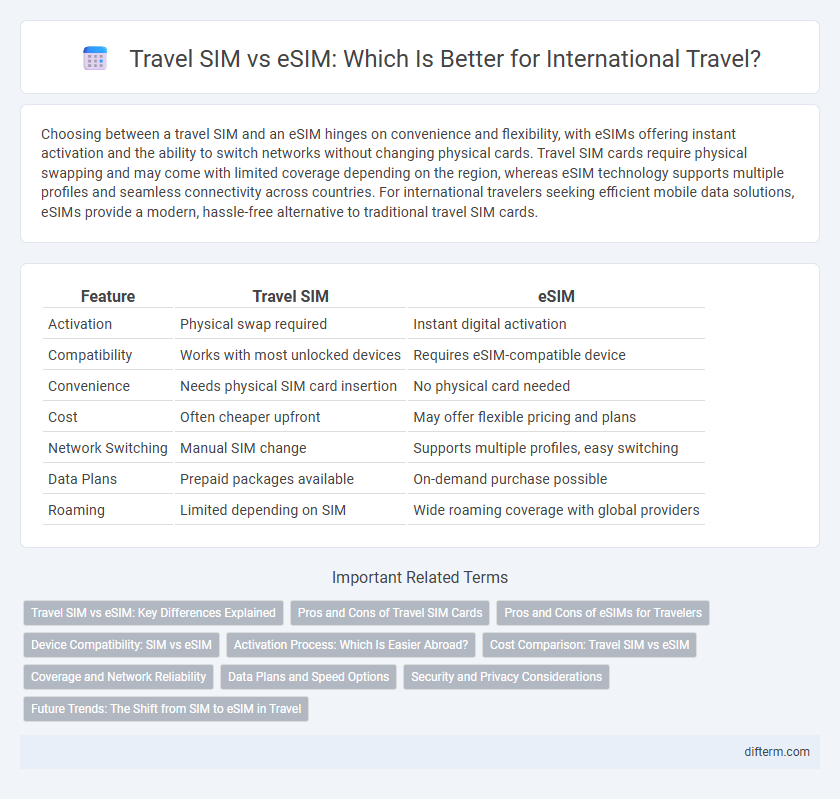Choosing between a travel SIM and an eSIM hinges on convenience and flexibility, with eSIMs offering instant activation and the ability to switch networks without changing physical cards. Travel SIM cards require physical swapping and may come with limited coverage depending on the region, whereas eSIM technology supports multiple profiles and seamless connectivity across countries. For international travelers seeking efficient mobile data solutions, eSIMs provide a modern, hassle-free alternative to traditional travel SIM cards.
Table of Comparison
| Feature | Travel SIM | eSIM |
|---|---|---|
| Activation | Physical swap required | Instant digital activation |
| Compatibility | Works with most unlocked devices | Requires eSIM-compatible device |
| Convenience | Needs physical SIM card insertion | No physical card needed |
| Cost | Often cheaper upfront | May offer flexible pricing and plans |
| Network Switching | Manual SIM change | Supports multiple profiles, easy switching |
| Data Plans | Prepaid packages available | On-demand purchase possible |
| Roaming | Limited depending on SIM | Wide roaming coverage with global providers |
Travel SIM vs eSIM: Key Differences Explained
Travel SIM cards require physical insertion into your device, offering compatibility with most unlocked phones but may involve swapping cards when traveling between countries. eSIMs are embedded digital SIMs that allow multiple profiles and instant switching without physical cards, supporting seamless connectivity in regions where eSIM technology is accepted. The choice depends on device compatibility, ease of use, and flexibility for travelers needing multi-country access with minimal hassle.
Pros and Cons of Travel SIM Cards
Travel SIM cards provide cost-effective access to local networks without the need for unlocking your phone, offering reliable coverage and straightforward installation in compatible devices. Their main downside includes physical card management, which can be inconvenient during frequent SIM swaps, and limited support for dual-SIM phones, potentially restricting simultaneous use of home and travel numbers. High roaming charges or limited data plans may arise if the selected SIM does not cover all destination countries extensively.
Pros and Cons of eSIMs for Travelers
eSIMs offer travelers the convenience of switching carriers without swapping physical SIM cards, providing instant access to local networks and avoiding SIM card loss or damage. However, eSIM compatibility is limited to newer devices, and not all countries support eSIM technology, which may restrict connectivity options in certain regions. Data plans on eSIMs can be more expensive compared to traditional SIM cards, impacting budget-conscious travelers who prioritize cost-effective solutions.
Device Compatibility: SIM vs eSIM
Traditional travel SIM cards require devices with physical SIM slots, limiting compatibility with newer smartphones, tablets, and laptops that may only support eSIM technology. eSIMs offer broader device compatibility, including the latest models from Apple, Samsung, and Google, enabling seamless switching between carriers without the need for a physical card. Travelers with eSIM-compatible devices benefit from enhanced convenience and access to multiple network plans, reducing dependency on physical SIM availability worldwide.
Activation Process: Which Is Easier Abroad?
Traditional travel SIM cards require physical swapping and manual activation through local carriers, often involving purchasing from a store or kiosk upon arrival. In contrast, eSIMs enable instant digital activation via QR codes or carrier apps before or upon reaching the destination, eliminating the need for physical cards and reducing activation time. This seamless process makes eSIMs the more convenient option for travelers seeking hassle-free connectivity abroad.
Cost Comparison: Travel SIM vs eSIM
Travel SIM cards generally offer lower upfront costs compared to eSIMs, especially for short-term use, as they often come with competitive local rates and no roaming fees. eSIMs provide cost efficiency for frequent travelers by enabling multiple profiles on a single device, eliminating the need to purchase multiple physical SIMs and allowing easy switching between carriers. However, eSIM plans tend to have higher activation fees and may include data packages that are priced at a premium compared to traditional travel SIM deals.
Coverage and Network Reliability
Travel SIM cards often provide extensive coverage by leveraging local network operators, ensuring strong signal strength and reliable connections in numerous countries. eSIM technology offers seamless network switching without physical card changes, enhancing convenience while maintaining high reliability through partnerships with multiple carriers worldwide. Both options deliver widespread network availability, but eSIMs excel in flexibility and instant activation, crucial for uninterrupted international travel connectivity.
Data Plans and Speed Options
Travel SIM cards often offer flexible data plans tailored for specific countries or regions, with competitive pricing and varying speed options such as 4G LTE and 5G connectivity. eSIM technology provides instant activation without physical cards, enabling travelers to switch between multiple data plans and carriers globally while maintaining fast, reliable internet speeds. Both options support high-speed data, but eSIMs offer greater convenience and seamless management for frequent international travelers seeking optimized mobile connectivity.
Security and Privacy Considerations
Travel SIM cards offer physical control over data access, reducing risks of remote hacking, while eSIMs enhance security by enabling encrypted profiles that can be remotely managed or deleted in case of device loss. eSIM technology supports instant identity updates and advanced authentication methods, minimizing the risk of SIM swap fraud, a common threat with traditional SIM cards. Privacy concerns are mitigated by eSIM's ability to isolate profiles and limit tracking across multiple networks, providing superior protection for travelers' personal information.
Future Trends: The Shift from SIM to eSIM in Travel
The travel industry is experiencing a significant transition from physical SIM cards to eSIM technology, driven by convenience and enhanced connectivity for international travelers. eSIMs eliminate the need for multiple SIM cards, allowing seamless switching between carriers and plans without changing hardware, which appeals to tech-savvy tourists and frequent flyers. Analysts predict eSIM adoption will surpass traditional SIM usage by 2027, as more global carriers support eSIM profiles and device manufacturers integrate eSIM capabilities into travel gadgets.
travel SIM vs eSIM Infographic

 difterm.com
difterm.com